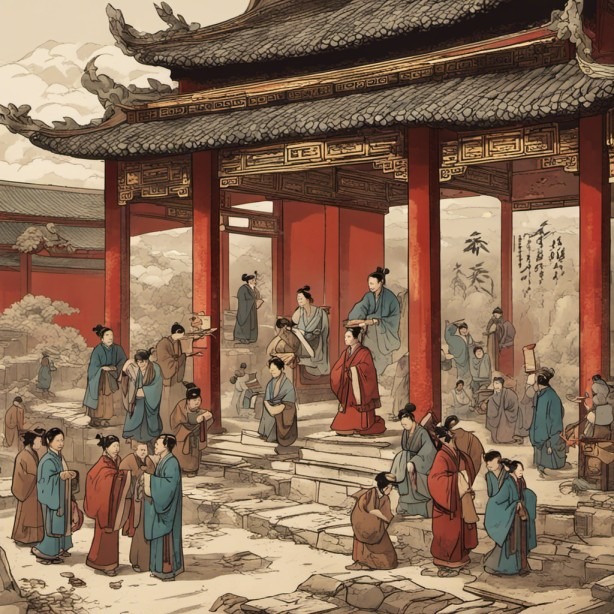
Ancient China’s Economy: A Legacy of Prosperity or Lessons from Decline
Sept 25, 2024
The Foundations of an Unyielding Economy
Beneath the veil of history lies an empire whose economic might was no accident but the fruit of relentless innovation and an indomitable spirit. Ancient China’s economy was a force forged through strategic ingenuity and relentless labour. Agriculture coursed like lifeblood through its vast expanse—millet fields in the north, rice paddies in the south—feeding not just bodies but the dreams of an empire.
These were no mere farmers but pioneers who reshaped the very earth. Iron ploughs slashed through stubborn soils, while advanced irrigation bent rivers to their will, transforming arid plains into lush fields. These advancements were nothing less than revolutions, redefining humanity’s dance with nature.
The well-field system showcased a genius of social engineering: families toiled their private plots but united to cultivate communal lands. This approach tightly woven communities with threads of shared purpose and collective strength.
The Rise of Cottage Industries
China’s ambitions didn’t stop at the furrows of the field. The rise of cottage industries revealed an unmatched resourcefulness. Homes doubled as workshops where silk shimmered into elegance, textiles whispered craftsmanship, and ironwork fueled the machinery of a burgeoning economy.
These industries weren’t mere hobbies but shields against nature’s whims. When floods ravaged crops or droughts dried the earth, these crafts kept livelihoods afloat, fostering resilience and self-sufficiency.
Commerce Expands Horizons
Cities pulsed with life as trade networks hummed. Merchants became the arteries of the empire, circulating goods and ideas across regions. The Silk Road was no mere trade route—it was a ribbon of influence, extending China’s reach far into Central Asia and beyond.
Money as a Tool of Dominion
China pioneered one of history’s most potent tools: coinage. By the 7th century BCE, bronze and copper coins weren’t just currency but instruments of power. Trade flourished, markets thrived, and economies hummed to the clink of coins.
Under the Qin Dynasty, the bold move to standardize currency cemented economic unity. Circular coins with square holes became symbols of cosmic order and pragmatic governance. The state manipulated coin supply to curb inflation, displaying a financial sophistication that kept calamity at bay.
The Paper Money Revolution
The Tang Dynasty transformed commerce by introducing paper money in the 9th century CE. Light and portable, it replaced cumbersome coins, revolutionizing trade and setting the stage for unprecedented economic growth. This leap wasn’t just innovation but a reimagining of wealth itself.
Trade and Commerce: The Empire’s Lifeblood
Trade was both an economic engine and a cultural ambassador. The Grand Canal, an engineering marvel, bound the empire’s north and south, ensuring resources flowed and power endured.
Merchant guilds orchestrated the dance of goods, provided financial services, and safeguarded their members’ interests. International trade showcased China’s dominance as silk, porcelain, and paper became global treasures. The Silk Road thrived as a conduit of ambition, spreading Chinese influence far beyond its borders.
By the 2nd century CE, China’s silk exports weren’t counted in spools but tons, commanding global markets. This monopoly wasn’t just economic; it was soft power wielded with precision.
The Calculated Hand of Government
China’s government was no passive observer—it was the architect of economic stability. Standardizing weights, measures, and currency eliminated trade discrepancies, bolstering unity and control.
Grain reserves ensured famine wouldn’t undo societal stability. The state manipulated market forces with the precision of a chess grandmaster. Monopolies on salt, iron, and liquor tightened its grip, transforming necessities into governance tools.
State-run workshops churned out goods while instilling loyalty. Taxation was ruthless but effective, ensuring no labour went uncounted and no grain went untaxed.
The Cataclysm of Decline
Even the mightiest empire can crumble from within. The late 18th and 19th centuries brought complacency and catastrophe. The White Lotus and Taiping Rebellions weren’t mere insurrections but signs of deep decay. The Industrial Revolution roared in the West while China clung to tradition, refusing the machines that could have transformed its economy.
The Opium Wars revealed vulnerabilities as foreign powers imposed humiliating treaties and carved out spheres of influence. Hong Kong’s cession was a stark symbol of decline.
Inertia in Innovation
China’s reliance on small-scale agriculture and handicrafts became its Achilles’ heel. Resistance to industrialization proved disastrous. China lagged as the world surged forward on steam and steel, a relic in the shadow of emerging industrial powers.
The Harsh Lessons of History
By the 20th century, the ancient economic order had disintegrated. Revolution swept the land, dismantling the old and rebuilding the new. The journey back to global prominence was arduous, but China’s resilience endured.
Conclusion
Ancient China’s economy is a tale of brilliance and caution, a chronicle of ambition and the perils of stagnation. It built an empire that dazzled the world, only to falter by resisting change.
Today, China reclaims its place on the world stage, proving that adaptation is the key to survival. Its story reminds us that power lies not in preserving the past but in embracing the future. As the modern world hurtles forward, those who dare to evolve will shape tomorrow’s destiny.
“Indeed, the saga of Ancient China’s economy is nothing short of a thrilling odyssey. From the fertile fields of millet in the north to the lush rice paddies in the south, ancient farmers laid the groundwork for a prosperous civilization. Their ingenuity, seen in inventions like iron ploughs and advanced irrigation, paved the way for abundant harvests and a thriving society.
The introduction of metal coinage and, later, the revolutionary concept of paper money brought unprecedented convenience to economic transactions. These innovations and the government’s vigilant management ensured stability and resilience.
Both domestic and international trade routes were the arteries that pumped life into the empire. The Grand Canal and the Silk Road transformed China into a global economic powerhouse, fostering cultural exchange and economic growth.
Yet, this incredible journey also bears the weight of decline. Political and economic challenges in the 18th and 19th centuries set in motion a series of events that reshaped the destiny of the ancient economy. The Opium Wars, unequal treaties, and isolationist policies shook the foundations.
Nonetheless, like a phoenix rising from the ashes, modern China emerged, determined to regain its position of global economic leadership. This rollercoaster ride through time underscores how even the most advanced societies can face seismic shifts and transformations.
As we reflect on the rise and fall of Ancient China’s economy, we are reminded that history is a teacher, illuminating the paths of innovation, resilience, and adaptation. In this ever-changing world, the lessons of the past continue to guide us toward a future brimming with opportunity and promise.”
Provoking Articles for the Curious










